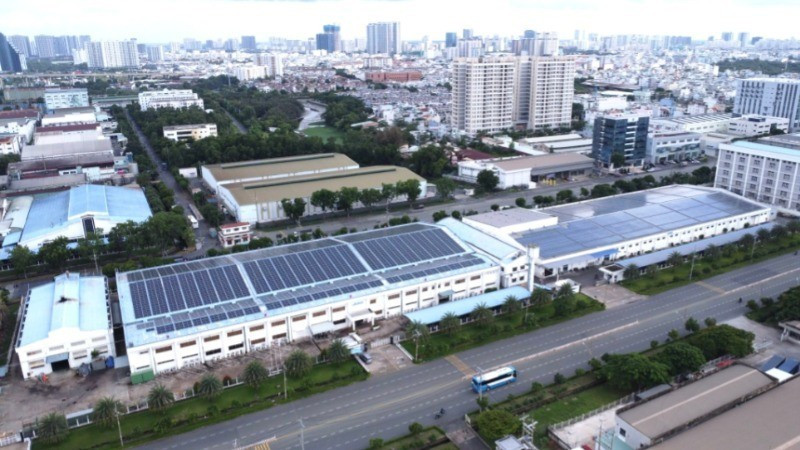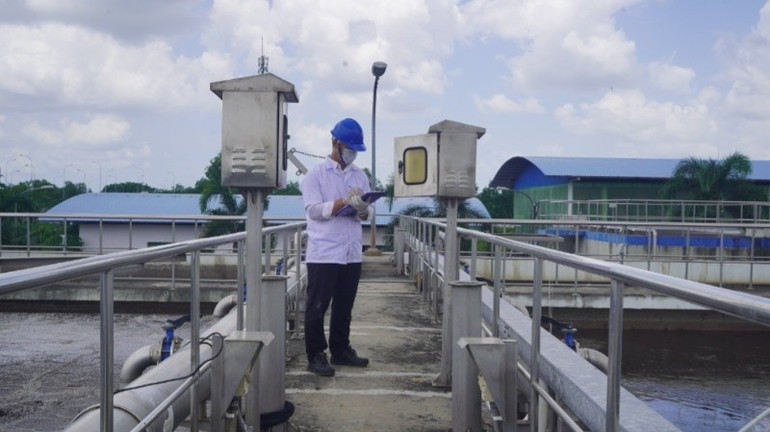Greening export processing zones and industrial parks to enhance investment value
The greening of export processing zones (EPZs) and industrial parks (IPs) to increase investment value, protect the environment and promote sustainable development is among the key goals in Ho Chi Minh City’s development planning for the new era, particularly following its administrative merger with Ba Ria–Vung Tau and Binh Duong.

Focusing on high-tech industrial parks
By focusing on attracting investment in high-tech industries and generating high added value in EPZs and IPs, Ho Chi Minh City has secured over 2.86 billion USD in investment over the past five years.
The recent issuance of an investment certificate for the Misa Campus Complex project in the Tan Thuan EPZ also marks a new chapter in the growth of Kotia SaiGon Joint Stock Company in the field of software research and development.
With a total investment of 600 billion VND and covering 1.2 hectares, the project encompasses software production, IT services, and technology transfer consultancy.
According to the Ho Chi Minh City Export Processing and Industrial Zones Authority (HEPZA), this project is seen as pivotal for the information technology sector. It will help establish a modern centre for innovation and software R&D meeting international standards, becoming a “magnet” for attracting high-quality tech talent to the zone.

Pham Thanh Truc, Deputy Head of HEPZA, stated that the implementation of the on-site “one-stop shop” administrative model has helped streamline procedures for businesses, making them more accessible, transparent and convenient.
This has significantly shortened project preparation times, reduced costs, and boosted investor confidence in a more modern and professional investment environment.
Moreover, the development of infrastructure in the city’s EPZs and IPs has seen impressive progress, with 531,242 square metres of multi-storey factory space constructed, 5.3 times higher than the target set for the 2020–2025 term, contributing to more efficient land use. This model, which is gaining ground in Tan Thuan EPZ, is expected to be replicated across other industrial areas in the city.
The workforce in these zones is technically skilled, adaptable, and increasingly proficient in applying scientific and technological innovations, in line with the demands of a market economy and global integration.
Most enterprises actively retrain workers to meet job requirements. In some companies, over 90% of employees hold a university degree.
To date, EPZs and IPs across the city have attracted more than 257,700 workers.
Between 2020 and 2025 alone, 132 new projects have come into operation, creating 26,090 jobs, 104% of the employment target set by HEPZA’s Party Committee (25,000 new jobs).
EPZs and IPs in Ho Chi Minh City have attracted more than 257,700 workers. Between 2020 and 2025, 132 new projects have commenced, generating 26,090 jobs, exceeding the target set by HEPZA’s Party Committee.
Determined to transform and enhance investment value
According to the master plan for the development of export processing zones (EPZs) and industrial parks (IPs), from now until 2033, Ho Chi Minh City will expand and invest in 14 new industrial parks with a total area of 3,833 hectares, in addition to the 17 existing EPZs and IPs. As part of this effort, the city is piloting the transformation of five zones into high-tech industrial parks, eco-industrial parks, integrated industrial–urban–service zones, and logistics centres.
Among these, eco-industrial parks and “green” parks with lower labour intensity are being prioritised for investment. The city is offering attractive policies to support appropriate transformation models, aiming toward Net Zero emissions.

Nguyen Tan Phong, Deputy General Director of Tan Thuan Co., Ltd., the investor and developer of Tan Thuan EPZ in District 7, shared that Tan Thuan was also the first industrial zone established in the city, with a history of 35 years. Its industries have mainly been labour-intensive and positioned at the lower end of the global value chain, making transformation essential to increasing added value.
Currently, about one-third of the enterprises in the zone operate with high levels of technology and added value, laying a solid foundation for the transformation. These firms focus on IT services, automotive components, semiconductors, and pharmaceutical biotechnology. Notably, companies in telecommunications, software, and IT services stand out and are expected to lead the transition while generating high investment value.
Pham Thanh Truc added that between 2025 and 2030, Ho Chi Minh City will allocate an average of 20 hectares per new industrial park, or 5% of each park’s total area, depending on specific conditions, for high-tech projects, small and medium-sized enterprises (SMEs), and innovative startups.
The city also plans to continue developing multi-storey factory models to improve land use efficiency. A special investment procedure will be introduced to streamline processes by integrating approvals for investment, construction, environmental compliance, and fire safety into a single, unified system.
“HEPZA is focusing on expanding the development space for industrial parks, establishing new high-tech zones, and building modern infrastructure integrated with urban-industrial areas equipped with full social amenities. The goal is to create a living and working environment that meets international standards, thereby attracting international experts and high-quality domestic personnel,” Truc said.
HEPZA also noted that the planned merger of Ba Ria – Vung Tau and Binh Duong provinces into Ho Chi Minh City would result in a new mega-city named Ho Chi Minh City, with socio-economic indicators far surpassing those of each individual locality. This will elevate the city’s status and scale, making it the country’s largest economic, financial and commercial hub, and the primary growth driver for both the Southeast region and the nation.
According to the Ho Chi Minh City Export Processing and Industrial Zones Authority, following the merger of the three localities, Ba Ria–Vung Tau, Binh Duong, and Ho Chi Minh City, the city is projected to attract between USD 20 billion and 21 billion USD in investment between 2025 and 2030.
The planned land allocation for EPZs and IPs will range from 13,000 to 13,300 hectares, with 6,500 to 6,800 hectares available for lease.
As for industrial park transformation, Ho Chi Minh City plans to convert four to five industrial parks into eco-industrial parks. Additionally, it will complete and implement pilot transformation schemes for five to six EPZs and IPs.








